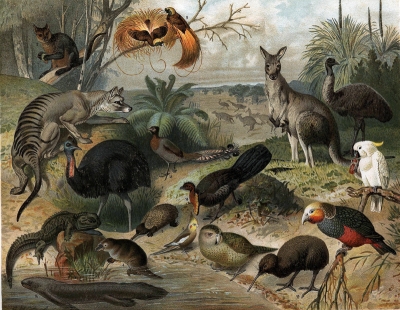
|
‘Fauna’ is a word for all the animal life within a region or period of time. The word comes from Greek mythology and roughly means ‘creatures of the wild’. The naturalist Carl Linnaeus was the first to use this term in 1974 in the title of his book Fauna Svecica, which means the ‘wildlife of Sweden’. |
History of Fauna
Fauna was first used as a biological term by naturalist Carl Linnaeus, as a term which described the animals of a region, as opposed to the plants. Plant life was dubbed flora. Thus, the flora and fauna of a region or time describe all of the life within. Linnaeus seems to have borrowed the term from Greek and Roman mythology.
In Greek mythology, the god Pan is the goat-legged offspring of a more powerful god and a wood nymph. This leads him to become the representative god of the wild. Roman mythology adopted this persona in the gods Faunus and Fauna, which gave rise to a number of man-creatures which populated the mythology. Linnaeus adopted the word for his formal work on the animals of Sweden Fauna Suecica, in 1745. Roughly translated, this means the “wildlife of Sweden”.
Following his lead, naturalists began to use the terms flora and fauna to identify the various living organisms in a taxonomic hierarchy. Flora included everything in the kingdom Plantae, while fauna included the kingdom Animalia. The definition of fauna has expanded and changed over the years. For instance, when genotyping became a reality and it was understood that there are actually 3 domains of life, the Archaea, Bacteria, and the Eukarya.
With this change came the formal phasing out of the word fauna, scientifically. While the word flora had maintained its definition as “any organism within the kingdom Plantae”, fauna had changed drastically. Fauna, as used currently, typically describes any organisms in the domains Archaea and Bacteria, plus the kingdom Animalia. This is not a monophyletic grouping, and as such does not accurately describe anything for scientists trying to organize the forms of life in a place or time. Further, flora and fauna tend to exclude the kingdom Fungi, which was once recognized as a plant but is now recognized as its own kingdom.
Examples of Fauna
Fauna of the Great Plains, 2018
If you were to conduct a survey, today, of all the fauna in the Great Plains of the United States, you would find a great many species. You would find many species of birds, from pheasants to eagles. You would find mammals, from the tiny field mouse to the mighty bison. Most other groups, from the reptiles to the worms, would also be represented. You would surely find an abundance of insects. On the microscopic level, the soil and waters are teeming with fauna. Even waters too acidic or hot for the normal fauna can host thermophilic or acidophilic bacteria and other organisms, evolved to deal with the harsh conditions. In essence, if you take the entirety of life on the Great Plains today, subtract all the plants, you have a representation of the fauna. This is obviously a large and intangible collection of many different inter-related species.
Fauna of the Great Plains, 100 Million Years Ago
If we could take ourselves back in time, the fauna of the Great Plains would look much different. Although we would remain in the same place, the environment would be very different. At that time, glaciers had melted to a low, and a vast inland sea had spread across the continental United States.
In this inland sea would have existed a variety of monsters, from the first modern sharks, to giant marine reptiles like Ichthyosaur and Plesiosaur. Modern bony fishes were evolving, as well as a variety of other marine organism. In this vast sea, you could have found everything from early starfish, to horseshoe crabs, to all sorts of evolving arthropods. Other fauna of the historical Great Plains would include the microscopic diatoms and zooplankton and algae, which would have been the base of the food-chain at the time. As the glaciers reformed, the land was colonized by the terrestrial organisms we know today. You can see how the fauna of a region can easily change over time.
Gut Fauna
A popular term these days is “gut fauna”, or in other words, the creatures living inside of your digestive tract. Humans, like almost all other animals, have a complex symbiotic relationship with the organism harbored within them. While there are barriers in place to keep these organisms from infecting the body, they are essential to digesting many types of food. Technically speaking, the fauna in the gut is referred to as the microbiome, because it is its own unique ecosystem. There are many species of bacteria and eukaryotes which take part in digestion, and each fills a unique niche in the ecosystem. While scientists have yet to fully understand the microbiome of the digestive system, there are many diets and probiotics on the market which claim to positively affect the fauna of the microbiome. These claims have yet to be confirmed by mainstream science.
Credit : Biology dictionary
Picture Credit : Google




